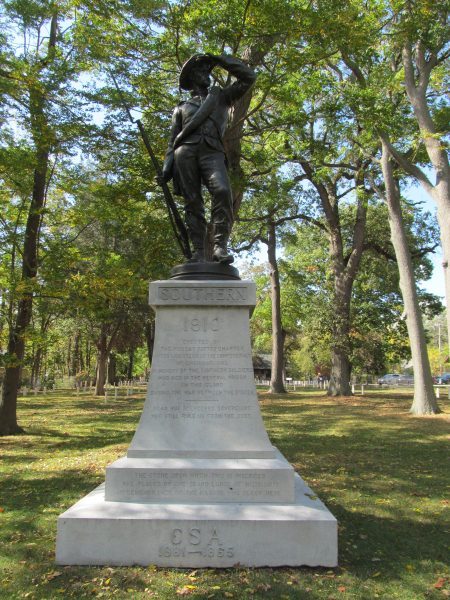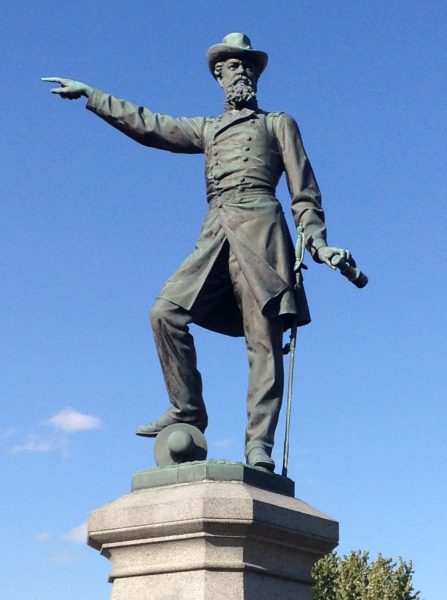Battlefield Markers & Monuments: Johnson Island & McPherson’s Grave
Emerging Civil War welcomes back Frank Jastrzembski to share about a recent trip and his musings on historical graveyard markers.
My wife reluctantly agreed to go on another of my weekend cemetery hunts. Only a few weeks before, we had taken another couple to visit Brevet Brigadier-General Orland Smith’s grave in Green Lawn Cemetery after a day at the Columbus Zoo. The best season to visit old cemeteries in Ohio is the fall. For our next trip, we headed west to hit both the Confederate cemetery on Johnson Island in Sandusky Bay and General James B. McPherson’s grave in Clyde, Ohio (a forty minute drive between the two).

This wasn’t the first time I had heard of the Johnson Island cemetery or of the prisoner-of-war camp. I had regrettably never made a point to visit the cemetery. I can now say that I had overlooked the most interesting cemetery in Ohio.
I like to visit the graves of Civil War generals since I live in Cleveland, Ohio, far from most Civil War battlefields. I find cemeteries just as fascinating as museums or battlefields. Most people find cemeteries creepy, but they have the opposite effect for me. How else can you get any closer to these historical figures?
We decided to take a day trip to Johnson Island on the first weekend of October to see what it was all about. It couldn’t have been a better day to travel; a nice breeze, leaves changing to all kinds of stunning colors, and plenty of sunshine. I made the same drive along OH-2 W probably fifty times to go to Put-In-Bay or the amusement park Cedar Point. It took us about an hour-and-a-half to arrive at Johnson Island’s causeway.
 For a fee of one dollar (the ticket machine only takes cash), we crossed the causeway to the privately owned 300-acre island (The causeway did not exist during the war). The cemetery, a National Historic Landmark, is open to the public from sunrise to dusk. You can’t miss it. The rest of the island has homes built on it where the original prison camp was located.
For a fee of one dollar (the ticket machine only takes cash), we crossed the causeway to the privately owned 300-acre island (The causeway did not exist during the war). The cemetery, a National Historic Landmark, is open to the public from sunrise to dusk. You can’t miss it. The rest of the island has homes built on it where the original prison camp was located.
The cemetery grounds are surrounded by a black iron gate, with 206 neatly arranged marble tombstones commemorating the Confederate soldiers who died during their internment in the prison camp. An informative sign with the history of Johnson Island is close to the parking lot.
Confederate officers were segregated from the regular soldiers at Camp Chase in Columbus, Ohio, and transported to Johnson Island Prison in 1862. The prison operated from April 1862 through September 1865. Over 10,000 officers spent time there during this period. Some notable Confederate prisoners included: Colonel Henry Kyd Douglas, Generals Isaac R. Trimble, James J. Archer, John R. Jones and M. Jeff Thompson.
 I walked down each row one at a time. I carefully glanced at the names, checking from what state each man came from and his army rank. I drifted from the center of the cemetery to the far corners (as I usually do) to pay my respects to those tombstones that likely get overlooked. These men were from all over the Confederacy. Some even came from as far as Texas or Arkansas. Most of the markers have names carved into them, but others are listed as unknowns. These marble markers replaced the original deteriorating wood markers after the war.
I walked down each row one at a time. I carefully glanced at the names, checking from what state each man came from and his army rank. I drifted from the center of the cemetery to the far corners (as I usually do) to pay my respects to those tombstones that likely get overlooked. These men were from all over the Confederacy. Some even came from as far as Texas or Arkansas. Most of the markers have names carved into them, but others are listed as unknowns. These marble markers replaced the original deteriorating wood markers after the war.
I continued to the main gate of the cemetery bordering Lake Erie. In the distance, I could clearly see Cedar Point. Streaming across the top of the gate in white are the words “Confederate Cemetery, 1861-1912.” Two newer markers with a few words about the cemetery and the names of those buried there flank a nineteen-foot bronze statue of a Confederate soldier looking off into the distance. This statue, sculpted by Moses Jacob Ezekiel, a Jewish VMI cadet wounded in the Battle of New Market in 1864, was dedicated in 1910.
 I sat on a nearby bench outside the front gate for a short while with my back facing the fence and in the direction of Lake Erie. A few other people were there too to pay their respects. My mind drifted to the men buried here, and I began to ask myself: What famous battles were these men captured in? Why were their bodies never returned home? Were they forgotten about by their families?
I sat on a nearby bench outside the front gate for a short while with my back facing the fence and in the direction of Lake Erie. A few other people were there too to pay their respects. My mind drifted to the men buried here, and I began to ask myself: What famous battles were these men captured in? Why were their bodies never returned home? Were they forgotten about by their families?
At first, I felt sympathy for these men. Then I thought, I couldn’t think of a better place for these soldiers to be buried. Well-maintained, protected from urban sprawl, and tucked away with a beautiful view, this was as serene as it gets. I experienced something in this cemetery, not something that I can easily describe, but it was powerful.
 If you are interested in learning more about the prison’s construction, a prisoner’s life in the camp, or the daring escape attempts (some of them successful), I recommend checking out Roger Long’s 1987 article in the Blue and Grey Magazine. It is a fascinating article, well worth a read.
If you are interested in learning more about the prison’s construction, a prisoner’s life in the camp, or the daring escape attempts (some of them successful), I recommend checking out Roger Long’s 1987 article in the Blue and Grey Magazine. It is a fascinating article, well worth a read.
My wife and I hopped back into our car and headed south toward Clyde. I always wanted to visit the grave of the highest-ranking Union general killed in the war. Now, being nearby, I had a reason. The cemetery is named after its most famous occupant.

I could quickly tell that the citizens of Clyde are proud of being connected with McPherson. His boyhood home (from the age of seven to thirteen) is still standing. In 2014, the citizens of Clyde celebrated the 150th anniversary of his funeral. Sandusky County Judge John Dewey made a speech and children of the community placed a large wreath by McPherson’s grave.
McPherson’s monument is impressive. It looks like a monument found on a battlefield like Shiloh or Gettysburg, not something you would find in a small Ohio town. At the highest point in the cemetery (be prepared to walk up a slope), a bronze McPherson appears to be issuing orders with one leg resting on a displaced cannon, while holding a pair of binoculars in his left hand. The statue is surrounded by cannon and cannonballs, and a large American flag in the background at half-mast. Satisfied with our afternoon trip having paid our respects to both Confederate and Union men (something I never thought I would be able to do in Ohio), we headed back to Cleveland to plan our next Civil War cemetery trip.


Thanks, Frank, for this heart-felt description of your experiences at Johnson’s Island and in Clyde. Though I live in Fairlawn now (an Akron suburb), I lived in Cleveland for 50 years. You might expect, therefore, that I too have visited the Island and Clyde. And you would be right. Several times. I can therefore identify completely with your feelings at both sites, having felt them myself. Was McPherson of higher rank than Corps Commanders Reynolds and Sedgwick? I vaguely recall that this question came up once before in this forum, but I do not recall the answer.
I’m certain Sedgwick had seniority in date of rank but I’m not sure about Reynolds vs. McPherson – I think they both were promoted in Fall, 1862.
Thank you! I was always under the impression that McPherson was the highest ranking Union general killed based on his command (Army of the Tennessee) at the time of his death.
John Sedgwick was the highest ranking Union general killed during the war. He was promoted to Maj. Gen. to date from July 4, 1862. James McPherson is second, with Maj. Gen. to date from Oct. 8, 1862, and Reynolds is 3rd, with his Maj. Gen. dating to Nov. 29, 1862.
Because Sedgwick’s date of promotion was before McPherson, he ranks higher.
As a traveling child I remember passing through many Ohio towns featuring Civil War statues and cannons in the town squares. Your enjoyable article rekindled the memories.
Ryan:
Thank you for this information.
See Friends of Johnson’s Island https://johnsonsisland.heidelberg.edu/about.html
The friends currently own approximately 17 acres of the former camp area and have been conducting archaeological digs there for several years in concert with Heidelberg College’s Dr. Dave Bush. One of the most pristine earthen forts in the nation (Bearss) can be seen there. Please support the Friends of Johnson’s Island by becoming a member. Attend Park Day (CWT) in the Spring and help clear brush at the former POW camp.
Thanks for the article! I grew up on Cleveland’s east side, but spent a lot of time on route 2(90) headed west to Sandusky. Yet, it wasn’t until I’d moved away that I stopped in at Johnson’s Island and visited the cemetery. Neat little bit of history.
Great piece Mr. Frank, glad you have a great wife who’s willing to spend her free time at your side on these trips. I’ve always studied and enjoyed reading about the Western Theater especially the Army of Tennessee. Having only a bach. degree in history I’m not as educated as you guys and ladies so maybe you can answer a question I’ve always had about McPherson-when he was killed Grant and Sherman wrote how they always thought if they were killed McPherson would take over not only the Army of Tennessee but the whole army-not to be disrespectful but that seems absurd to me-what did he do to deserve such consideration?
Thanks for the article. My wife and I attended the Memorial Day parade and the service several years ago. My Great great grand father Moses Ready, was a prisoner on the island, died there and is buried there. He was from Georgia and died late Feb 1864, only about 6 weeks before the end of the war. I have 9 letters written to his wife while he was a prisoner in the island. Memorial Day on Johnson is awesome.